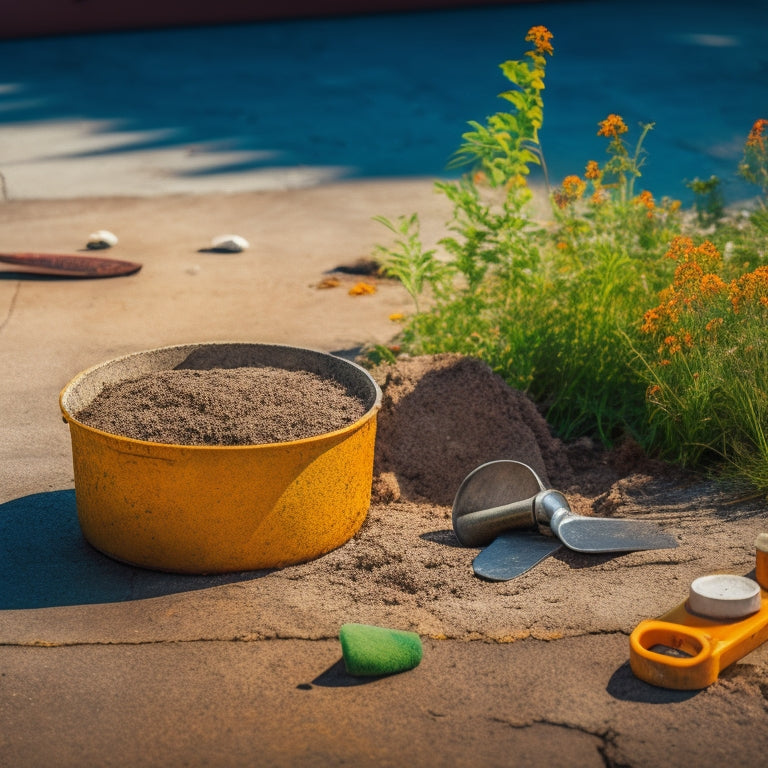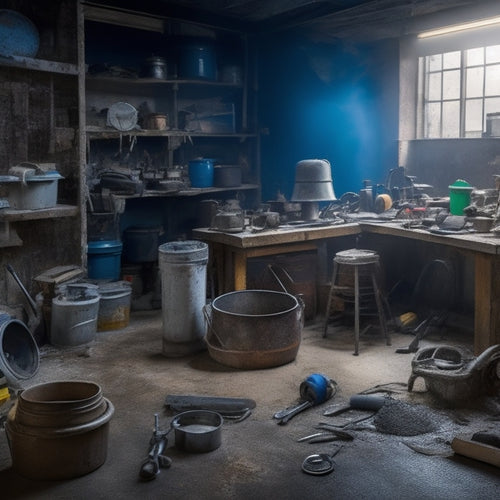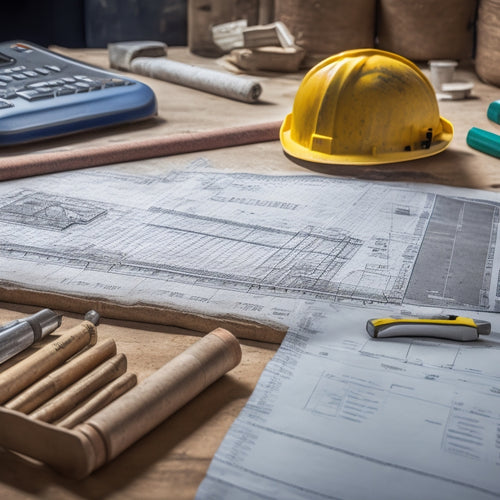
Best Tools for Concrete Repair on a Budget
Share
You'll need a strategic blend of tools to tackle concrete repair on a budget. Start with essential power tools like a rotary hammer or hammer drill, variable-speed drill with mixing paddle attachment, and impact driver. For drilling and cutting, choose the right drill bits, hammer drills, and saws for the job. Mixing and smoothing require the right mixers and trowels. Chiseling and edging tools like chisels, demolition hammers, and grinders will also be necessary. By selecting the best tools for each task, you'll be able to complete your concrete repair project efficiently and effectively - and uncover more tips and tricks to get the job done right.
Key Takeaways
- Invest in essential power tools like rotary hammers, variable-speed drills, and impact drivers for efficient concrete repair.
- Choose a high-torque drill with variable speed control and a suitable chuck type for accommodating different anchor sizes.
- Select the right drill bits, such as twist, masonry, step, and core bits, for effective concrete penetration without damage.
- Consider budget-friendly mixer options like handheld mixers, drill-mounted mixers, and paddle mixers for cost-effective concrete mixing.
- Regularly clean, inspect, and store tools properly to maintain their performance, extend their lifespan, and ensure safety.
Power Tool Selection for Wall Repair
When tackling wall repair, your power tool selection can make all the difference in efficiency and outcome. Choosing the right tools can streamline concrete patching techniques and guarantee a strong, lasting bond.
For surface preparation, you'll need a reliable rotary hammer or hammer drill to remove old, damaged concrete and create a clean surface for patching.
A variable-speed drill with a mixing paddle attachment is essential for mixing and applying patching compounds. Consider an impact driver for applying anchors or screws, especially in harder concrete.
Don't forget a dustless vacuum and dust mask to contain debris and protect yourself from inhaling hazardous particles.
Opt for a tool with adjustable torque to avoid over-tightening, which can damage the surrounding concrete. Additionally, select tools with ergonomic design and comfortable grip to reduce fatigue during extended use.
Best Drills for Concrete Anchors
Frequently, you'll find yourself needing to drill into concrete to set anchors, and in those situations, having the right drill makes all the difference. A drill's ability to efficiently and effectively drill into concrete depends on several key features.
Look for drills with high torque and variable speed control, as these will allow you to adjust to different anchor types and concrete densities. Additionally, a drill's chuck type and size will impact its ability to accommodate various anchor sizes.
When selecting a drill for concrete anchors, consider the type of anchors you'll be using. For example, if you're working with sleeve anchors, you'll want a drill with a strong hammer function to help set the anchor. On the other hand, if you're using wedge anchors, a drill with a high-speed setting will be more suitable.
Other essential drill features include a durable build, comfortable grip, and reliable battery life (if cordless). By choosing a drill that matches your anchor type and concrete needs, you'll guarantee a successful and efficient concrete repair process.
Top Hammer Drills for Repair
You'll need a hammer drill that can efficiently handle concrete repair tasks, which means selecting the right drill bit and considering the power and performance of your tool.
When it comes to drill bit selection, you'll want to choose bits designed specifically for concrete, as they'll provide the best results.
Drill Bit Selection
Selecting the right drill bit is crucial for efficient concrete repair. You'll want to choose a bit that can effectively penetrate the concrete without damaging it or the surrounding material.
There are various drill bit types and sizes to take into account, and making the right selection can make all the difference.
When it comes to drill bit selection, contemplate the following:
-
Twist bits: These are the most common type of drill bit and are suitable for drilling small holes in concrete.
-
Masonry bits: These bits have a tungsten carbide tip and are designed specifically for drilling into masonry materials like concrete.
-
Step bits: These bits have a stepped design that allows for drilling holes of varying sizes.
- Core bits: These bits are designed for drilling large holes and are often used for applications like anchor bolt installation.
Remember to choose a drill bit that matches the size and type of hole you need to drill.
Using the wrong drill bit can lead to poor results, wasted time, and increased costs. By selecting the right drill bit, you can guarantee a successful and efficient concrete repair job.
Power and Performance
With the right drill bit in hand, it's time to focus on the power behind the operation: the drill itself. You'll want a top hammer drill that can deliver the necessary force and speed to effectively repair concrete without compromising its durability.
When it comes to concrete repair, you need a drill that can withstand the demands of the job. Look for a drill with high torque and RPM ratings to guarantee you can efficiently drill through concrete without overheating the motor.
For peak performance, consider a drill with a sturdy motor that can handle the rigors of concrete repair. A drill with a high power-to-weight ratio will provide the necessary force without being too heavy or cumbersome.
Additionally, look for features like adjustable torque control and variable speed to fine-tune your drilling technique. By choosing the right drill for the job, you can assure your concrete repair techniques are effective and efficient, resulting in a durable and long-lasting repair.
Cost-Effective Mixer Options
Your concrete repair project's success hinges on having the right mixer to get the job done efficiently. As you investigate cost-effective options, evaluate the mixer types and mixing techniques that will help you achieve the desired results.
Here are four mixer options to evaluate:
-
Handheld Mixers: Ideal for small to medium-sized projects, handheld mixers are affordable and easy to use. They're perfect for mixing small batches of concrete or patching compound.
-
Drill-Mounted Mixers: These mixers attach to your drill, providing more power and efficiency than handheld mixers. They're suitable for larger projects and can handle thicker mixes.
-
Paddle Mixers: These mixers feature a paddle attachment that's designed for mixing heavy, thick materials like concrete. They're often more expensive than handheld or drill-mounted mixers but offer superior performance.
- Wheelbarrow Mixers: These mixers are designed for large-scale projects and can handle massive quantities of concrete. They're often the most expensive option but provide unparalleled efficiency and productivity.
When choosing a mixer, evaluate the size of your project, the type of mix you're working with, and your budget.
Essential Trowels for Smoothing
After getting the right mixer for your concrete repair project, it's time to focus on the tools that'll help you achieve a smooth, even finish.
You'll need a range of trowels to tackle different stages of the smoothing process. For initial smoothing, a bull float or fresno trowel is ideal. These trowels have a large, flat surface that helps to remove excess material and create a level surface.
For finer smoothing, switch to a finishing trowel or a pool trowel. These trowels have a smaller, more curved blade that allows for more precise control and a higher level of finish.
When using these trowels, employ a gentle, sweeping motion to remove any imperfections and create a smooth, even surface.
Remember to use the correct trowel type and smoothing techniques for your specific concrete repair project. Experiment with different trowel types and techniques to find what works best for you.
Affordable Grinders for Edging
Precision is key when it comes to edging, and the right grinder can make all the difference.
You'll want a grinder that provides control, maneuverability, and the right features for your edging techniques.
When shopping for an affordable grinder for edging, consider the following key features:
-
Variable speed control: Allows you to adjust the grinder's speed to suit the task at hand, ensuring a precise finish.
-
Compact design: Enables you to access tight spaces and corners with ease, making it ideal for edging.
-
Dust collection system: Helps minimize mess and keeps your workspace clean, reducing the risk of inhaling dust particles.
- Ergonomic grip: Provides comfort and reduces fatigue, allowing you to work for extended periods without strain.
Budget-Friendly Chiseling Tools
Many concrete repair projects require breaking up and removing old or damaged concrete, which is where chiseling tools come in.
You'll need to master various chiseling techniques to efficiently remove damaged concrete without damaging the surrounding structure. When working on a budget, you can't afford to invest in high-end chiseling tools.
Instead, look for budget-friendly alternatives that still get the job done. A set of heavy-duty chisels made from budget materials like high-carbon steel can be an excellent starting point.
These chisels are durable, resistant to wear, and can withstand the rigors of breaking up concrete. You can also consider using a demolition hammer, which is a versatile tool that can be used for both chiseling and breaking up concrete.
When choosing a demolition hammer, look for one with a sturdy build, comfortable grip, and adjustable handle to reduce fatigue.
With the right chiseling tools and techniques, you'll be able to remove damaged concrete efficiently and effectively, even on a tight budget.
Efficient Saws for Cutting Concrete
You're about to tackle one of the most critical steps in concrete repair: cutting through the damaged concrete to access the underlying structure. This requires efficient saws designed specifically for concrete cutting. With the right saw, you'll make clean cuts, reduce dust, and increase productivity.
When choosing a saw, consider the following:
-
Wet saws: Ideal for large-scale projects, wet saws reduce dust and heat buildup, making them perfect for prolonged use.
-
Dry saws: Lightweight and portable, dry saws are ideal for smaller projects, but may generate more dust.
-
Concrete circular saws: Designed for heavy-duty cutting, these saws feature specialized blades and are perfect for thick concrete.
- Reciprocating saws: Versatile and adaptable, reciprocating saws are great for tight spaces and demo work.
Remember to follow proper concrete cutting techniques, such as using the correct blade type and maintaining a steady pace.
Regular saw maintenance tips include cleaning the blade, checking for wear, and storing the saw properly to extend its lifespan.
Frequently Asked Questions
Can I Use a Cordless Drill for Concrete Repair?
You can use a cordless drill for concrete repair, but it is crucial to choose the right drill type and technique for the job, as high-torque drills with hammer functionality are best suited for mixing and drilling into concrete.
How Do I Prevent Dust When Drilling Into Concrete?
As you venture into the concrete jungle, remember, dust is the sly enemy, waiting to ambush your drilling operation; outsmart it with dust control strategies like vacuum-equipped drills, and expert drilling techniques like slow, steady strokes to minimize the dust storm.
Are Epoxy-Based Repair Products Suitable for Outdoor Use?
When evaluating epoxy-based repair products for outdoor use, you'll want to take into account their epoxy durability under various outdoor conditions, such as UV exposure, temperature fluctuations, and moisture, to guarantee a long-lasting and effective concrete repair.
Can I Repair Concrete Cracks With a DIY Kit?
You're a DIY concrete expert, tackling cracks like a pro! Yes, you can repair concrete cracks with a DIY kit, and it's surprisingly effective for minor crack sealing, but be prepared for varying results depending on the kit's quality and your application skills.
Do I Need to Wear Protective Gear When Working With Concrete?
When working with concrete, you'll need to take safety precautions seriously, so don't skip wearing protective equipment like gloves, safety glasses, and a dust mask to prevent skin and eye irritation, and respiratory problems.
Conclusion
You've made it through the gauntlet of concrete repair on a budget. Pat yourself on the back, because you've earned the right to a slightly-less-broken bank account. With these tools, you'll be well on your way to mediocre repairs that will last until the next minor earthquake. Congratulations, you've achieved the bare minimum! Now go forth and pretend those hairline cracks aren't a structural issue.
Related Posts
-

7 Tools to Fix Damaged Concrete Floors
You're about to tackle that damaged concrete floor, and the right tools are essential for a successful repair. Start ...
-

7 Must-Have Tools for Concrete Repair Organization
To effectively organize your concrete repair projects, you'll need a thorough toolkit that includes a well-planned st...
-

5 Tips for Accurate Concrete Measurement Tools
To guarantee accurate concrete measurement, you'll want to calibrate your measuring tools regularly, choosing a frequ...


